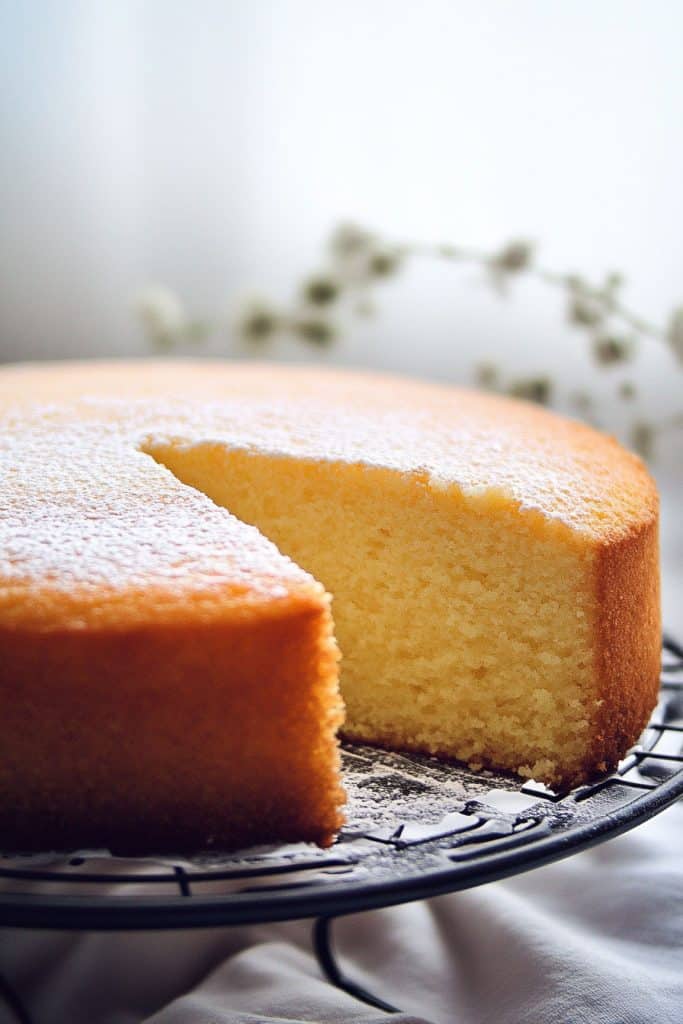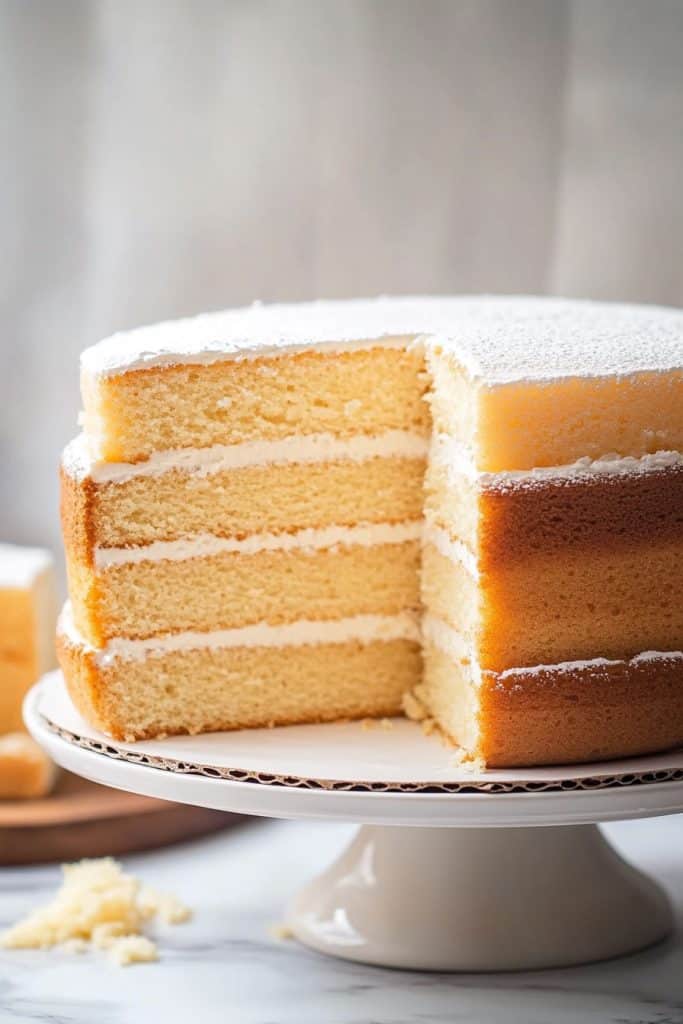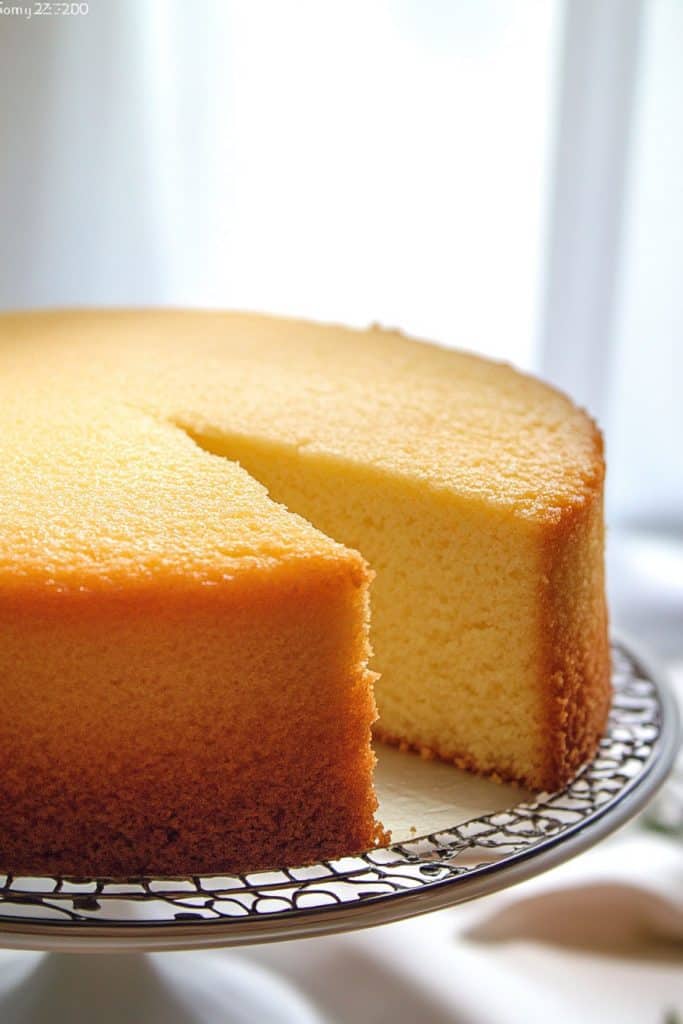If you’re a fan of light, airy cakes, then the Genoese sponge is about to become your new favorite. Originating from Genoa, Italy, this classic sponge cake stands out for its delicate texture and rich flavor, all achieved without any chemical leavening agents. The magic lies in the technique of whipping eggs and sugar to a voluminous, frothy consistency, which gives the cake its signature lift.

Ingredients
Here is a list of precise, carefully chosen ingredients required to create the perfect Genoese sponge cake. Make sure you measure them accurately to achieve the desired light and airy texture.
- 4 large eggs: At room temperature.
- 1 cup granulated sugar: Ensure it’s granulated for the right consistency.
- 1 cup all-purpose flour: Sifted to remove any lumps and ensure a light texture.
- 1/4 cup unsalted butter: Melted and cooled, adding richness without weighing down the cake.
- 1 teaspoon vanilla extract: For a subtle, aromatic flavor.
- Pinch of salt: Enhances the overall flavor.
Make sure to follow the order of the ingredients as listed. The sequence, along with proper preparation of each ingredient, will ensure your Genoese sponge achieves its classic, delicate texture.
Special Equipment
To achieve the perfect Genoese sponge cake, specific equipment is essential due to the cake’s delicate and airy nature. Here’s a detailed list of the special equipment you will need:
- Stand Mixer with Whisk Attachment:
A stand mixer with a whisk attachment is crucial for whipping the eggs and sugar to the necessary volume and consistency. The continuous, powerful mixing ensures the eggs reach their full frothy potential without deflating. - Kitchen Scale:
Precision in measurements is vital for the Genoese sponge cake. A kitchen scale will help you accurately measure ingredients, especially the flour and sugar, ensuring the perfect texture and lift of the cake. - Fine-Mesh Sieve:
For aerating and sifting the flour to prevent lumps. A fine-mesh sieve ensures that the dry ingredients are well-incorporated and helps in maintaining a light and airy batter. - 8-inch Round Cake Pan:
An 8-inch round cake pan is ideal for this recipe. Choose a high-quality, non-stick pan to promote even baking and easy release of the cake without damaging its delicate structure. - Parchment Paper:
Lining the cake pan with parchment paper prevents the sponge from sticking and tearing. It assists in a smooth removal, preserving the cake’s light texture and appearance. - Rubber Spatula:
A rubber spatula is perfect for gently folding the flour into the whipped eggs and sugar mixture. The gentle folding ensures that the air incorporated during whipping is not lost, maintaining the cake’s structure.
Incorporating these tools into your baking process will help you achieve the authentic light and fluffy texture characteristic of a well-made Genoese sponge cake.
Prepping Your Ingredients
Getting your ingredients ready is a critical step in ensuring the perfect Genoese sponge cake. Accurate measurement and preparation make all the difference in achieving the cake’s signature light texture.
Dry Ingredients
- All-Purpose Flour: Measure out 1 cup (120 grams) of all-purpose flour. Sift it twice using a fine-mesh sieve to ensure it is aerated and lump-free.
- Cornstarch: Add 2 tablespoons (16 grams) of cornstarch to the sifted flour. This helps in achieving a tender crumb.
- Salt: Measure 1/4 teaspoon of salt and add it to the dry mixture for balancing flavors.
- Large Eggs: You’ll need 4 large eggs at room temperature. Room temperature eggs ensure better volume when whipped.
- Granulated Sugar: Measure out 2/3 cup (135 grams) of granulated sugar. This will be whipped with the eggs until it reaches a voluminous, ribbon-like consistency.
- Unsalted Butter: Melt 1/4 cup (56 grams) of unsalted butter and then cool it to a lukewarm temperature. It will be folded in at the end to add richness without deflating the batter.

Directions
Here is the step-by-step process to achieve the perfect Genoese sponge cake with its signature light and airy texture.
Preparing the Batter
- Preheat your oven to 350°F (175°C). Grease a 9-inch (23 cm) round cake pan and line the bottom with parchment paper.
- Combine 1 cup (130 g) all-purpose flour and 2 tablespoons (16 g) cornstarch, and sift them together three times. This ensures an even mix and prevents any lumps.
- Melt 4 tablespoons (57 g) unsalted butter in a small saucepan over low heat. Keep it warm.
- In a large mixing bowl, whip 4 large eggs with 3/4 cup (150 g) granulated sugar using a stand mixer on high speed. Continue for about 8 to 10 minutes until the mixture is pale, thick, and tripled in volume.
Folding Technique
- Using a spatula, fold the sifted flour mixture into the whipped eggs and sugar gently. Incorporate 1/3 of the flour at a time, folding carefully to preserve the air in the batter.
- Add the warm melted butter in a thin stream, folding it in as you go. This step should be done delicately to maintain the batter’s volume.
Baking the Genoise
- Pour the prepared batter into the greased and lined cake pan, smoothing the top with a spatula.
- Place the pan in the preheated oven and bake for 25 to 30 minutes. The cake should rise and turn a golden brown.
- Test the cake by inserting a toothpick into the center. If it comes out clean with a few moist crumbs, the cake is done.
- Remove the cake from the oven and let it cool in the pan for about 10 minutes. Then, transfer it to a cooling rack to cool completely.
By following these detailed steps, you will create a Genoese sponge cake that is fluffy and perfect every time.

Tips for the Perfect Genoise Sponge
Creating an impeccable Genoise sponge requires both precision and a touch of finesse. Here are some vital tips to help you master this delicate cake.
Use Room Temperature Eggs
Ensure that your eggs are at room temperature before starting. Cold eggs won’t whip to their fullest volume, compromising the desired light and airy texture. I recommend taking the eggs out of the refrigerator at least an hour before you plan to start baking.
Thoroughly Whip Eggs and Sugar
The key to a fluffy Genoise sponge is adequately whipped eggs and sugar. Use an electric mixer to beat the eggs and sugar mixture until it’s tripled in volume and pale in color. This process usually takes about 8-10 minutes. You know you’ve achieved the right consistency when you can lift the whisk, and the mixture forms a ribbon that holds its shape for a few seconds.
Sift the Flour
Sift the flour twice to remove any lumps and incorporate air. This will ensure that the flour folds smoothly into the egg mixture, preventing deflation of the batter. I recommend using cake flour as its lower protein content will result in a finer, more tender crumb.
Fold Gently
When incorporating the sifted flour and melted butter, fold gently using a spatula. Use a motion that goes around the bowl and then through the center, turning the bowl as you fold. This technique helps maintain the airiness of the batter. Over-mixing or stirring too vigorously can deflate the mixture.
Melt and Cool the Butter
The butter should be melted and then allowed to cool slightly before being added to the batter. If the butter is too hot, it can deflate the egg mixture. Use clarified butter if possible, as it incorporates more seamlessly without affecting the texture.
Bake Immediately
Once the batter is ready, pour it into the prepared cake pan and bake immediately. If the batter sits too long, it will lose volume, resulting in a denser sponge. Preheat your oven early and ensure your cake pan is prepared with parchment paper.
Check for Doneness
To check if your Genoise sponge is done, gently press the center of the cake. It should spring back lightly. Additionally, a toothpick inserted in the center should come out clean. Avoid opening the oven door during baking, as this can cause the cake to collapse.
Cool Properly
Cool the Genoise sponge on a wire rack. Removing it from the pan too soon can cause it to deflate. Let it cool in the pan for about 10 minutes before carefully transferring it to a rack to cool completely.
By following these tips, you will achieve a perfectly light and airy Genoise sponge every time. The precision in each step ensures that all the efforts result in a delightful and impressive cake.

Fillings, Frostings, and Flavor Ideas
Fillings
Filling a Genoese sponge brings it to life. Here are a few of my favorites:
- Raspberry Jam: Spread a generous amount of raspberry jam between the layers for a delightful tartness.
- Italian Buttercream: Whip up a smooth Italian buttercream and add in fresh fruit preserves for extra flavor.
- Lemon Curd: Brighten your cake with a zesty lemon curd for a refreshing twist.
- Pastry Cream: Fill the layers with rich, velvety pastry cream for a luxurious bite.
Frostings
The right frosting can elevate your Genoese sponge to a whole new level. Consider these options:
- Whipped Cream: Light and airy, whipped cream frosting pairs perfectly with the delicate texture of the sponge.
- Chocolate Ganache: For a decadent treat, coat your cake in a silky, smooth chocolate ganache.
- Cream Cheese Frosting: Add a tangy contrast with a luscious cream cheese frosting.
- Swiss Meringue Buttercream: Achieve a beautiful, glossy finish with a Swiss meringue buttercream.
Flavor Ideas
Enhance your Genoese sponge by infusing it with exciting flavors:
- Vanilla Bean: Add scraped vanilla bean seeds to the batter for a classic, aromatic touch.
- Citrus Zest: Incorporate lemon or orange zest into the batter for a burst of citrus flavor.
- Almond Extract: A few drops of almond extract can create a distinctive, nutty undertone.
- Espresso: Mix in a shot of cooled espresso for a sophisticated coffee flavor.
Creative Combinations
Experimenting with combinations can yield remarkable results:
- Strawberry Shortcake: Fill with strawberry jam and cream, then top with fresh strawberries and whipped cream.
- Tiramisu-Inspired: Soak the layers in espresso, fill with mascarpone cream, and dust with cocoa powder.
- Tropical Delight: Use coconut milk in the batter, fill with mango purée, and frost with coconut-flavored whipped cream.
- Chocolate Orange: Add orange zest and chopped dark chocolate to the batter, fill with chocolate ganache, and frost with orange buttercream.
Remember, the sky’s the limit when it comes to Genoese sponge cakes. Mixing and matching fillings, frostings, and flavors can create a personalized masterpiece.

Make-Ahead and Storage
Making a Genoese sponge cake ahead of time can save a lot of hassle, especially if you’re planning an event or special occasion. To ensure the best quality, follow these steps for storing your cake.
Storing the Cake
- Cooling Completely: Once your Genoese sponge has baked, let it cool completely on a wire rack. This prevents any condensation from making the cake soggy.
- Wrapping: Wrap the cooled cake tightly in plastic wrap. Be thorough in ensuring the entire cake is covered to prevent it from drying out or absorbing any fridge or freezer odors.
Storage Options
Room Temperature
- Timing: If you plan to use the cake within 24 hours, storing it at room temperature is fine.
- Conditions: Ensure the wrapped cake is stored in a cool, dry place away from direct sunlight.
Refrigerator
- Shelf Life: In the refrigerator, a well-wrapped Genoese sponge can last up to three days.
- Best Practices: Place the wrapped cake in an airtight container to provide an extra layer of protection against moisture and odors.
Freezer
- Extended Storage: For longer storage, you can freeze the Genoese sponge. It will maintain its quality for up to three months.
- Freezing Instructions:
- Double-wrap the cake in plastic wrap.
- Follow this by wrapping it in aluminum foil or placing it in a freezer-safe zipper bag.
- Label with the date for easy tracking.
Defrosting and Using
- Room Temperature Thawing: To defrost, remove the cake from the freezer and keep it wrapped. Allow it to thaw at room temperature for several hours or overnight.
- Refrigerator Thawing: Alternatively, you can thaw it in the refrigerator for 24 hours.
- Re-whipping Cream and Frostings: If assembled with whipped cream or other frostings, re-whip as needed after storage to regain texture.
- Refreshing Texture: For a just-baked feel, consider lightly brushing the cake with simple syrup after thawing.
By following these steps, you can create your Genoese sponge cake in advance without sacrificing its light and airy texture.

Conclusion
Mastering the art of Genoese sponge cake opens up a world of delicious possibilities. With its light and airy texture, this cake serves as the perfect canvas for a variety of fillings and frostings. Whether you’re aiming for a classic combination or experimenting with new flavors, the versatility of the Genoese sponge ensures that your creations will always impress.
Remember that proper storage techniques can help maintain the cake’s quality, allowing you to prepare in advance without any loss of flavor or texture. So go ahead and unleash your creativity—your next baking masterpiece is just a Genoese sponge away.
